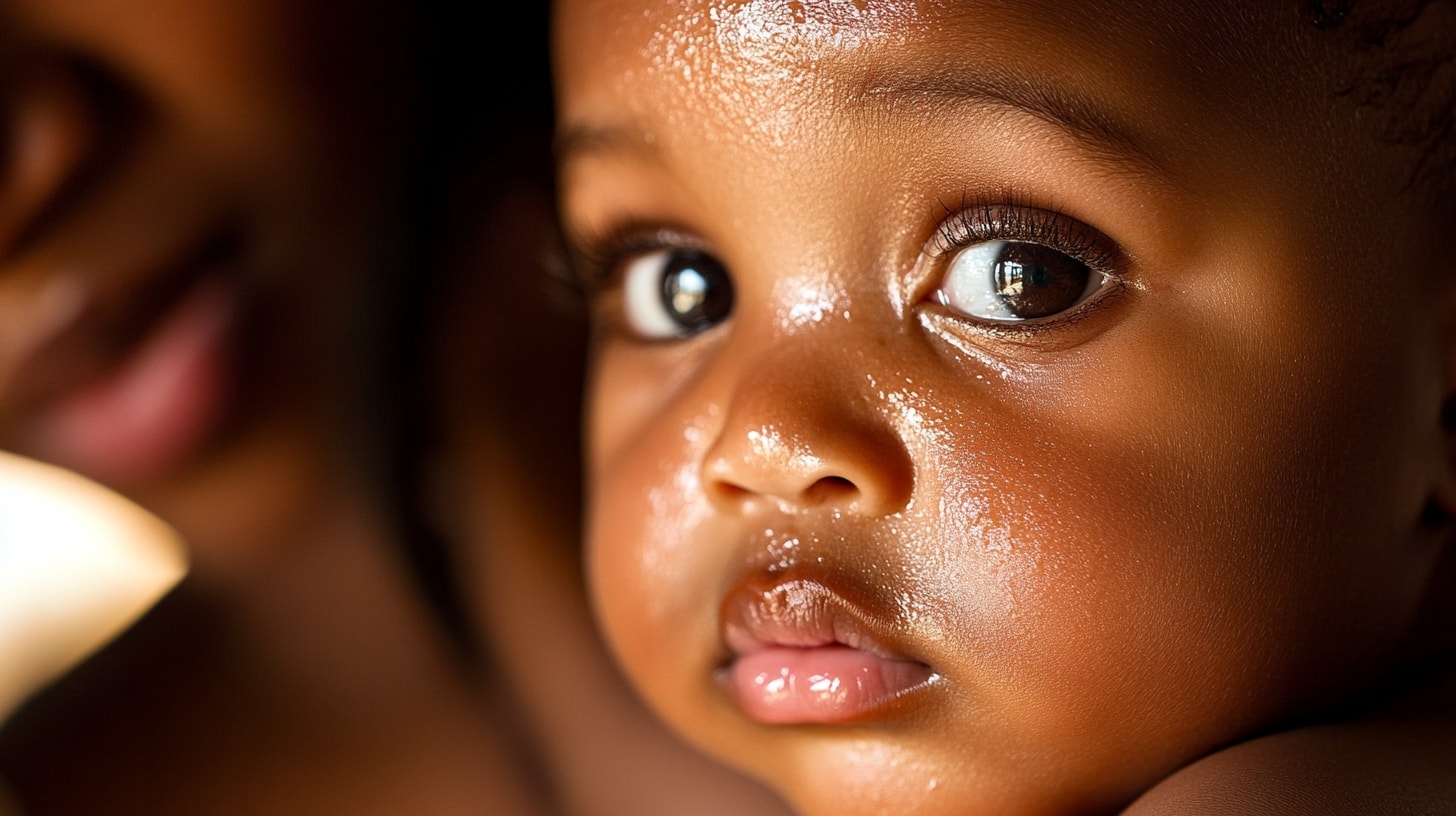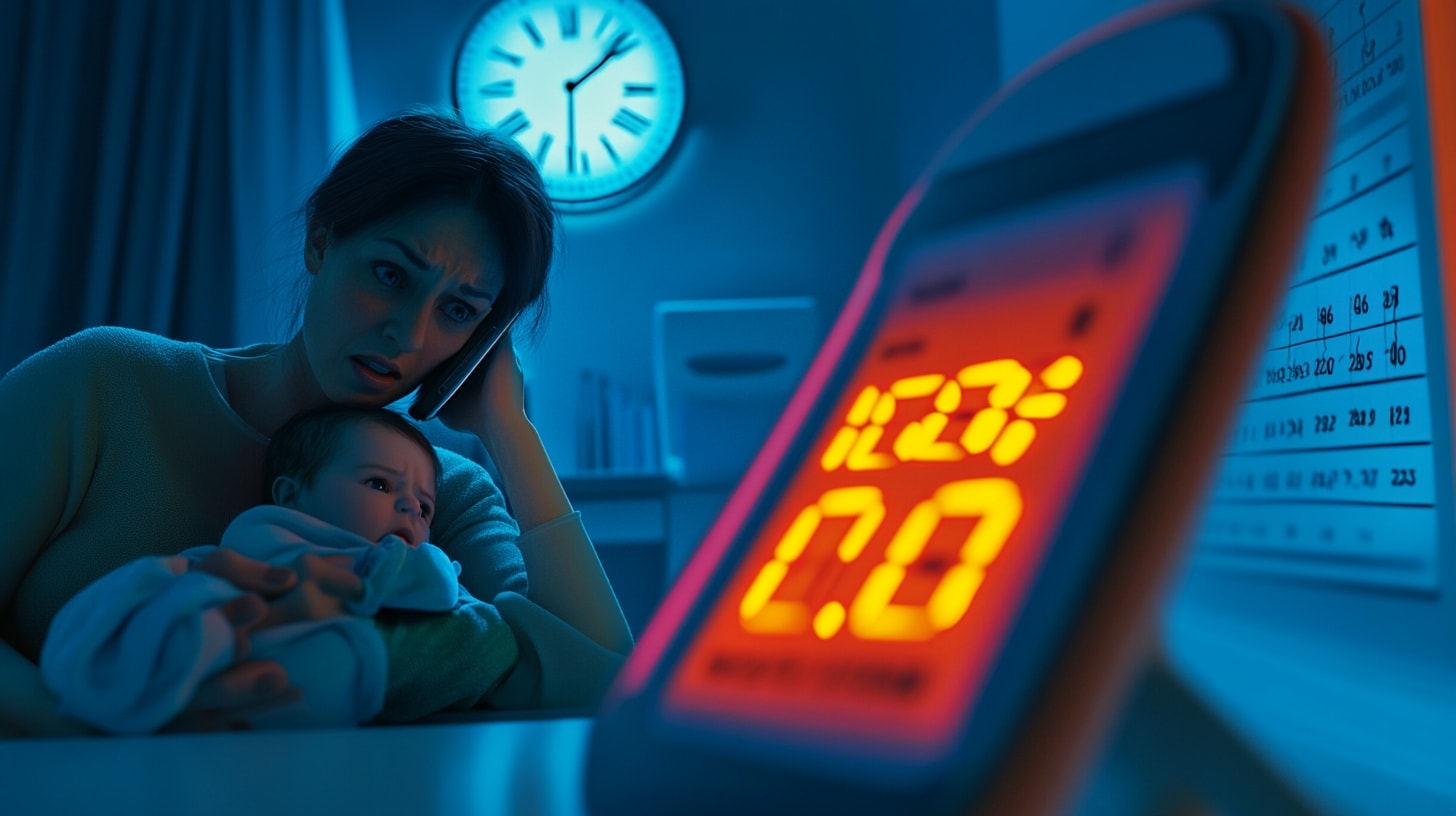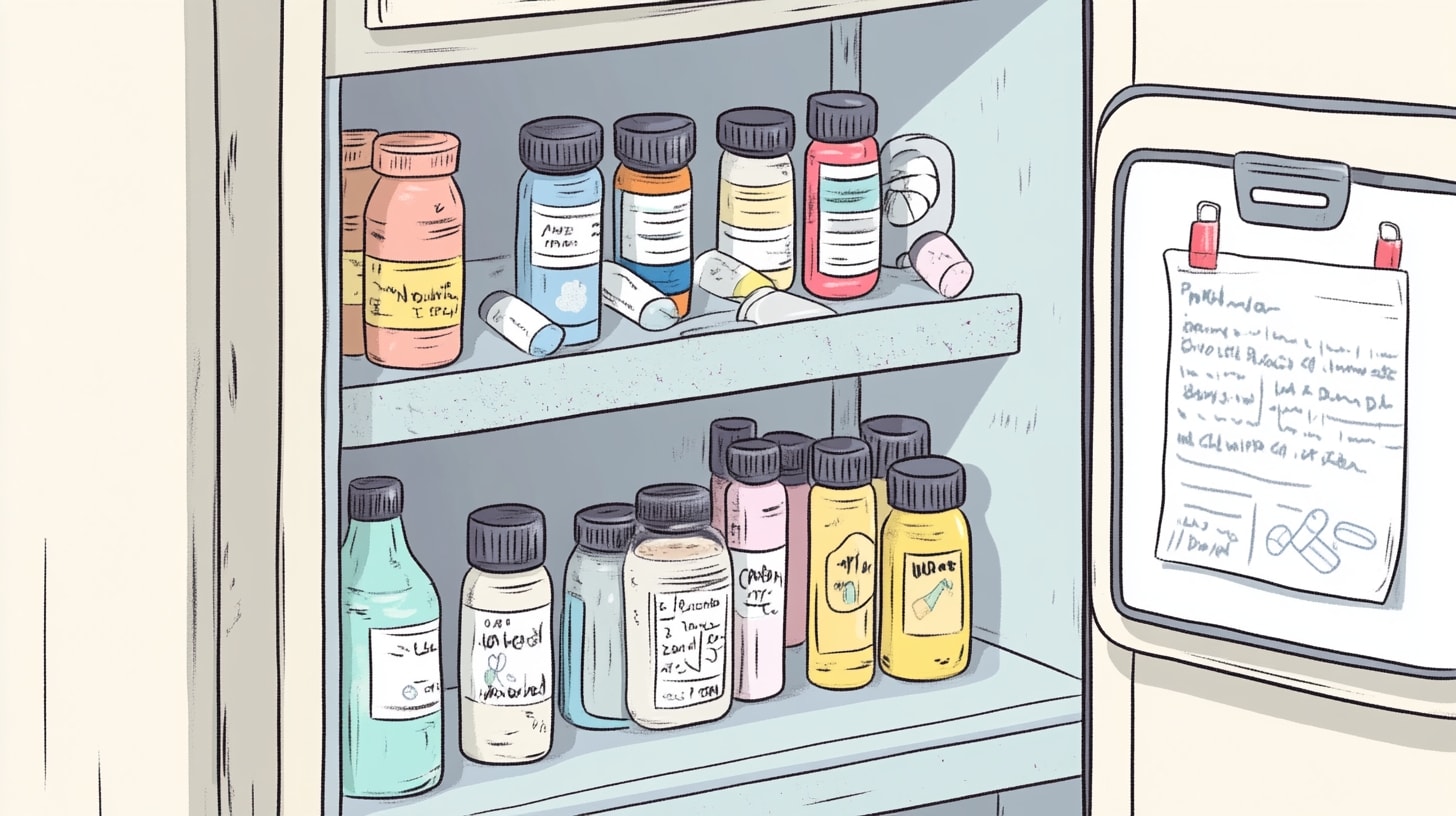Table of Contents
ToggleBaby’s Got a Fever? Don’t Sweat It! Caribbean Wisdom Meets Modern Medicine
Picture this: It’s 2 AM, and your little bundle of joy is burning up like a Jamaican jerk chicken grill. Your heart’s racing faster than Usain Bolt, and you’re wondering if you should be dialing 911 or your abuela for that secret fever remedy. Sound familiar? Well, my fellow sleep-deprived warrior, you’ve come to the right place!
As a parent who’s survived more midnight fever scares than I care to count, I’m here to guide you through the hot (pun intended) topic of baby fevers. We’re going to dive into everything from spotting the signs to whipping up some Caribbean cool-down magic. So grab your thermometer and a cup of ginger tea, because we’re about to become fever-fighting pros!

Is It Hot in Here, or Is It Just My Baby? Decoding Fever Signs
Let me tell you, the first time my little one got a fever, I was convinced the world was ending. But here’s the thing – babies are like tiny furnaces, and sometimes they just run a little hot. So how do you know when it’s actually a fever?
First off, trust your parent instincts. If your baby feels warmer than a fresh patty out the oven, it’s time to investigate. Here are some telltale signs to watch for:
- Flushed cheeks redder than a ripe sorrel
- Sweating more than your uncle at a dance hall
- Unusual fussiness (beyond their normal where’s my bottle? protests)
- Less energy than a sloth on vacation
- Poor appetite (refusing even their favorite mango puree)
Now, before you start panicking like it’s your first time making rice and peas, remember that a slight temperature doesn’t always mean trouble. Babies can get warm from overdressing, overexcitement, or even a particularly vigorous tummy time session. The key is to know how to check that temp like a pro.

Taking the Heat: Mastering the Art of Temperature Checking
Alright, it’s time to channel your inner scientist and get that temperature reading. But before you start poking and prodding, let’s talk tools. Forget the old-school mercury thermometers – they’re about as outdated as using a landline to call your bestie. Digital is the way to go, my friends.
Now, where to stick that thermometer? Well, it depends on your baby’s age and your comfort level with, ahem, certain areas. Here’s the lowdown:
- Rectal: The gold standard for accuracy, especially for babies under 3 months. Yes, it’s as fun as it sounds (not).
- Armpit: Less invasive, but also less accurate. Good for a quick check.
- Ear: Quick and easy, but can be tricky to position correctly.
- Forehead: The least disruptive method, but also the least accurate.
Whichever method you choose, make sure you’re gentle and follow the instructions carefully. And for the love of all things holy, don’t use the same thermometer for different body parts. That’s a mix-up you definitely want to avoid!
Once you’ve got that number, here’s what you need to know: A normal temp for babies is between 97°F and 100.4°F (36°C to 38°C). Anything over 100.4°F is considered a fever. But don’t freak out just yet – we’ve got some tricks up our sleeve to bring that temp down.

Caribbean Cool-Down: Home Remedies That’ll Make Your Abuela Proud
Now, before you rush to the medicine cabinet, let’s talk about some good old-fashioned Caribbean remedies. These have been passed down through generations, probably since the time when dinosaurs roamed Jamaica (okay, maybe not that long, but you get the idea).
First up, the magic of bush tea. I swear, Caribbean people have a tea for everything, and fever is no exception. A mild peppermint or chamomile tea can work wonders. Just make sure it’s cooled down and safe for your baby’s age. And no, adding rum is not appropriate, no matter what your uncle says.
Next, let’s talk about the cooling power of coconut water. This natural elixir is packed with electrolytes and can help prevent dehydration. Plus, it’s a lot tastier than those fancy rehydration solutions. Just be sure to use fresh coconut water, not the sugary stuff from the store.
Another trick straight from the islands is the famous vinegar sock. Sounds weird, I know, but hear me out. Soak a pair of socks in cool water mixed with a bit of apple cider vinegar, wring them out, and put them on your baby’s feet. Cover with dry socks and watch that fever melt away like ice cream in the Caribbean sun.
And let’s not forget the power of a good old-fashioned lukewarm bath. Add a few drops of lavender oil for extra soothing power. It’s like creating your own little spa for your baby – minus the cucumber slices and gossip magazines, of course.

When to Call in the Cavalry: Knowing When It’s Doctor Time
Alright, so you’ve tried every remedy short of dancing around in a circle chanting fever, fever, go away, but that temperature’s still climbing higher than a coconut tree. When is it time to wave the white flag and call the doc?
Here’s your cheat sheet:
- For babies under 3 months: Any fever over 100.4°F (38°C) is a drop everything and go situation.
- For babies 3-6 months: If the fever hits 102°F (38.9°C) or lasts more than 24 hours, it’s time to make that call.
- For babies 6 months and older: If the fever reaches 103°F (39.4°C) or lasts more than 3 days, get that doctor on the line.
But remember, these are just guidelines. If your gut is telling you something’s not right, listen to it. You know your baby better than anyone else. And if your little one is showing signs of dehydration, difficulty breathing, or unusual lethargy, don’t wait – get medical help right away.
I’ll never forget the time my daughter’s fever spiked to 104°F in the middle of the night. I was ready to call the emergency services, the neighbors, and possibly the ghost of Bob Marley for help. But a quick call to our pediatrician’s after-hours line gave us the guidance we needed. Sometimes, a professional voice of reason is all you need to calm those panicked parent nerves.

Fever Fighters: When to Break Out the Big Guns (aka Medicine)
Okay, so we’ve tried all the home remedies, channeled our inner Caribbean grandmas, but that stubborn fever is still hanging around like an uninvited guest at a beach party. Now what? It might be time to consider some over-the-counter reinforcements.
But before you start popping pills like they’re tic-tacs, let’s talk about when and how to use fever reducers safely. First things first – fever reducers are not always necessary. Sometimes, a fever is just your baby’s body doing its job, fighting off those pesky germs. However, if your little one is uncomfortable or the fever is high, medication can help.
The two main players in the fever-fighting game are acetaminophen (Tylenol) and ibuprofen (Motrin, Advil). Here’s the lowdown:
- Acetaminophen: Safe for babies 2 months and older
- Ibuprofen: Only for babies 6 months and older
Always, and I mean ALWAYS, follow the dosage instructions on the package. Overdosing on these meds can be dangerous, and underdosing is about as effective as trying to cool down your baby with a fan made of palm leaves.
Pro tip: Keep a chart to track when you give medication. Trust me, in your sleep-deprived state, you’ll thank me later when you’re trying to remember if you gave that last dose at 2 AM or 3 AM.
And here’s a little secret from my own fever-fighting arsenal: alternate between acetaminophen and ibuprofen (if your baby is old enough). This tag-team approach can be more effective than using just one medication. But always, always check with your doctor before trying this strategy.
Remember that time I accidentally gave my son a double dose of Tylenol because I forgot I’d already given him some? Yeah, not my finest parenting moment. Cue frantic calls to the poison control center and a very stern talking-to from our pediatrician. Lesson learned: always communicate with your partner about medication given, and maybe invest in a giant whiteboard for your kitchen.
Fever Aftermath: Bouncing Back and Staying Cool
Congratulations, warrior! You’ve battled the fever and come out victorious. Your baby’s temperature is back to normal, and you’re ready to collapse into bed for a well-deserved nap. But before you drift off into dreamland, let’s talk about the aftermath.
First off, don’t be surprised if your little one isn’t immediately back to their usual self. They might be extra clingy, less interested in food, or just generally out of sorts. This is normal. Think about how you feel after being sick – not exactly ready to run a marathon, right?
Here are some tips to help your baby bounce back:
- Keep up with the fluids: Offer plenty of breast milk, formula, or water (if they’re old enough)
- Rest, rest, rest: Let them sleep as much as they need
- Gentle foods: If they’re eating solids, start with bland, easy-to-digest options
- Extra TLC: Cuddles and comfort are the best medicine
Now, let’s talk prevention. While you can’t bubble-wrap your baby to protect them from every germ (tempting as it may be), there are some steps you can take to reduce the chances of another fever fiasco:
- Handwashing: Make it your new religion. Teach everyone who comes near your baby to wash their hands like they’re about to perform surgery.
- Avoid sick people: I know, easier said than done. But if Aunty Mildred has the sniffles, maybe she can admire the baby via FaceTime for now.
- Breastfeeding: If you’re able to, breast milk is packed with antibodies that can help boost your baby’s immune system.
- Healthy diet: For older babies, a diet rich in fruits and veggies can help keep their immune system strong.
And here’s a little personal anecdote for you: After my daughter’s first big fever scare, I became a bit of a germaphobe. I was sanitizing everything in sight, including the poor family dog. It took a heart-to-heart with our pediatrician (and maybe a glass of rum punch) for me to realize that some exposure to germs is actually good for building a strong immune system. Balance, my friends, is key.
The Cool Conclusion: You’ve Got This, Hot Stuff!
Alright, my fever-fighting friends, we’ve come to the end of our temperature-taming journey. You’re now armed with the knowledge to tackle fevers like a pro, whether you’re channeling your inner Caribbean grandma or reaching for the medicine cabinet.
Remember, fevers are a normal part of childhood. They’re your baby’s body doing exactly what it’s supposed to do – fighting off those nasty germs. But that doesn’t make them any less scary for us parents. So cut yourself some slack if you find yourself panicking at 3 AM over a warm forehead.
The key takeaways? Trust your instincts, keep calm (or at least try to), and don’t be afraid to reach out for help when you need it. Whether it’s calling your pediatrician, phoning a friend, or hey, even reading this blog post again (I won’t judge), support is out there.
And on those nights when you’re pacing the floor with a feverish baby, remember this: This too shall pass. Before you know it, your little one will be back to their usual self, probably destroying your living room or refusing to eat anything but chicken nuggets.
So here’s to you, amazing parents. May your thermometers always be accurate, your remedies always work, and your baby’s temperature always be just right. You’ve got this!
Now, if you’ll excuse me, I think I hear my own little one calling. Time to go see if it’s a real fever or just a case of I don’t want to go to bed syndrome. Wish me luck!
Expertise: Sarah is an expert in all aspects of baby health and care. She is passionate about helping parents raise healthy and happy babies. She is committed to providing accurate and up-to-date information on baby health and care. She is a frequent speaker at parenting conferences and workshops.
Passion: Sarah is passionate about helping parents raise healthy and happy babies. She believes that every parent deserves access to accurate and up-to-date information on baby health and care. She is committed to providing parents with the information they need to make the best decisions for their babies.
Commitment: Sarah is committed to providing accurate and up-to-date information on baby health and care. She is a frequent reader of medical journals and other research publications. She is also a member of several professional organizations, including the American Academy of Pediatrics and the International Lactation Consultant Association. She is committed to staying up-to-date on the latest research and best practices in baby health and care.
Sarah is a trusted source of information on baby health and care. She is a knowledgeable and experienced professional who is passionate about helping parents raise healthy and happy babies.
- Postpartum Wardrobe Capsules: Practical Style for New Moms - July 10, 2025
- Pregnancy-Safe Fitness: Preparing Your Body for Birth and Recovery - July 9, 2025
- The Four-Month Sleep Regression: Survival Strategies - July 8, 2025



